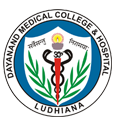CME on Retinal Diseases 17th May,2014
Department of Ophthalmology and Ludhiana Ophthalmological Society jointly conducted first of its kind CME on Retinal Diseases for General Ophthalmologists of the region. The function was formally inaugurated by lighting of ceremonial by the chief guest Sh Prem Kumar Gupta, Secretary of DMCH Managing Society. In his address, Sh Gupta said that in the recent past, Department of Ophthalmology has been equipped with latest ultramodern equipments for the treatment of various eye disorders.Also present during inauguration were Vice President Sh Amrit Nagpal, Principal Dr Daljit Singh and Additional Medical Supdt. Dr Sandeep Sharma.
  Organizing Chairman Dr GS Bajwa (Professor & Head of Ophthalmology) extended warm welcome to the dignitaries and participating delegates. According to Dr Bajwa, retina plays a pivotal role for and when the retina is injured, vision is seriously threatened and may be lost entirely if the problem is not quickly addressed. As retinal specialists, optical coherence tomography (OCT) is used to cure retinal disorders including vitreoretinal interface disorders, systemic and ocular vasculopathies, and ocular inflammatory disease. Organizing Chairman Dr GS Bajwa (Professor & Head of Ophthalmology) extended warm welcome to the dignitaries and participating delegates. According to Dr Bajwa, retina plays a pivotal role for and when the retina is injured, vision is seriously threatened and may be lost entirely if the problem is not quickly addressed. As retinal specialists, optical coherence tomography (OCT) is used to cure retinal disorders including vitreoretinal interface disorders, systemic and ocular vasculopathies, and ocular inflammatory disease.
 Organizing Secretary-Dr Sumeet Chopra (Associate Professor of Ophthalmology) said that many retinal diseases share common symptoms and treatments, but each has unique characteristics. The goal of organizing this CME is to update the participating delegates about recent advancements in treatment of retinal disorders Organizing Secretary-Dr Sumeet Chopra (Associate Professor of Ophthalmology) said that many retinal diseases share common symptoms and treatments, but each has unique characteristics. The goal of organizing this CME is to update the participating delegates about recent advancements in treatment of retinal disorders
The CME began with lecture on ‘Latest advances in management of intraocular tumours’ by Dr Mahesh Shanmugam from Banglaore followed by lecture on ‘Surgical Management of Diabetic Retinopathy’ by Dr Preetam Singh from Amritsar
.
An elaborative lecture on ‘Advances in management of Age-related macular degeneration ( ARMD) was given by Dr Ramandeep Singh from PGIMER,Chandigarh.In his lecture, Dr Ramandeep said that it is now more important than ever to recognize ARMD. New treatments are available now-a-days, which can prevent visual loss to a large extent and may even improve vision considerably. |







